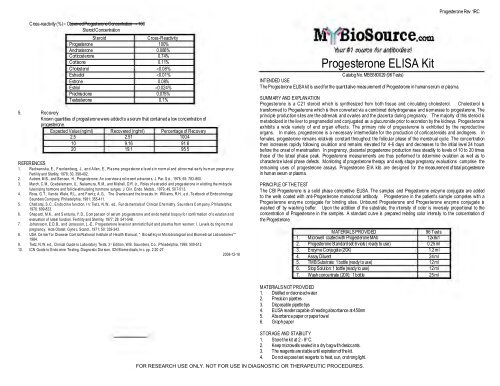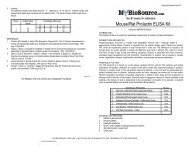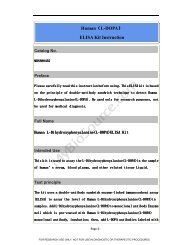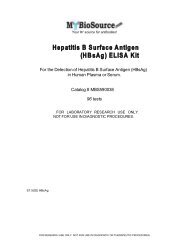Progesterone ELISA Kit - MyBioSource
Progesterone ELISA Kit - MyBioSource
Progesterone ELISA Kit - MyBioSource
Create successful ePaper yourself
Turn your PDF publications into a flip-book with our unique Google optimized e-Paper software.
<strong>Progesterone</strong> Rev.1RC<br />
Cross-reactivity (%) = Observed <strong>Progesterone</strong> Concentration ´ 100<br />
Steroid Concentration<br />
Steroid<br />
Cross-Reactivity<br />
<strong>Progesterone</strong> 100%<br />
Androsterone 0.086%<br />
Corticosterone 0.74%<br />
Cortisone 0.11%<br />
Cholesterol
WARNINGS AND PRECAUTIONS<br />
1. Potential biohazardous materials:<br />
The calibrator contain human source components, which have been tested and found non-reactive for hepatitis B<br />
surface antigen as well as HIV antibody with FDA licensed reagents. However there is no test method that can<br />
offer complete assurance that HIV, Hepatitis B virus or other infectious agents are absent. These reagents should<br />
be handled at the Biosafety Level 2, as recommended in the Centers for Disease Control/National Institutes of<br />
Health manual, "Biosafety in Microbiological and Biomedical Laboratories" 1984.<br />
2. This test kit is USA FDA exempt product.<br />
3. Do not pipette by mouth. Do not smoke, eat, or drink in the areas in which specimens or kit reagents are handled.<br />
5. The components in this kit are intended for use as an integral unit. The components of different lots should not be<br />
mixed.<br />
6. It is recommended that standards, control and serum samples be run in duplicate.<br />
7. Optimal results will be obtained by strict adherence to this protocol. Accurate and precise pipetting, as well as<br />
following the exact time and temperature requirements prescribed are essential. Any deviation from this may yield<br />
invalid data.<br />
SPECIMEN COLLECTION HANDLING<br />
1. It is recommended to collect serum samples with commercially available equipments. The serum samples should<br />
be completely colorless even the slight red color shows blood contamination.<br />
2. Specimens may be stored refrigerated at (2-8° C) for 1 days. Store frozen at (-20° C) for up to one month.<br />
3. Avoid multiple freeze-thaw cycles.<br />
4. Prior to assay, frozen serum samples should be completely thawed and mixed well.<br />
REAGENTS PREPARATION<br />
1. Working Reagent A <strong>Progesterone</strong>-enzyme Conjugate Solution<br />
Dilute the <strong>Progesterone</strong> enzyme conjugate 1:21 with assay diluent in a suitable container. For example, dilute<br />
100µ l of conjugate with 2ml of assay diluent buffer for 10 wells (A slight excess of solution is made).<br />
2. Wash Buffer<br />
Prepare 1X Wash Buffer by adding the contents of the bottle (25ml, 20X) to 475 ml of distilled or deionized water.<br />
Store at room temperature.<br />
ASSAY PROCEDURE<br />
Prior to assay, bring all reagents to room temperature. Gently mix all reagents before use.<br />
1. Place the desired number of coated strips into the holder<br />
2. Pipet 10 ml of <strong>Progesterone</strong> standards, control and patient’s serum samples.<br />
3. Add 200ml of <strong>Progesterone</strong> Enzyme Conjugate to all wells.<br />
4.<br />
5.<br />
Incubate for 60 minutes at room temperature (18-26° C).<br />
Remove liquid from all wells. Wash wells three times with 300 ml of 1X wash buffer. Blot on absorbent paper<br />
towels.<br />
6. Add 100 ml of TMB substrate to all wells.<br />
CALCULATION OF RESULTS<br />
The standard curve is constructed as follows:<br />
1. Check <strong>Progesterone</strong> standard value on each standard vial. This value might vary from lot to lot. Make sure you<br />
check the value on every kit. See example of the standard attached.<br />
2. To construct the standard curve, plot the absorbance for <strong>Progesterone</strong> standards (vertical axis) versus<br />
<strong>Progesterone</strong> standard concentrations (horizontal axis) on a linear graph paper. Draw the best curve through the<br />
points.<br />
3. Read the absorbance for controls and each unknown sample from the curve. Record the value for each control or<br />
unknown sample.<br />
Standard Curve<br />
Standard<br />
Optical Units (450 nm)<br />
Standard 1 (0 ng/ml) 2.20<br />
Standard 2 (2.5 ng ml) 1.32<br />
Standard 3 (5 ng/ml) 0.92<br />
Standard 4 (10 ng/ml) 0.65<br />
Standard 5 (20 ng/ml) 0.42<br />
Standard 6 (40 ng/ml) 0.23<br />
<strong>Progesterone</strong> Rev.1RC<br />
EXPECTED VALUES<br />
It is recommended that each laboratory establish its own normal ranges based on a representative sampling of the local<br />
population. The following values for <strong>Progesterone</strong> were established by the CBI and may be used as initial guideline<br />
ranges only:<br />
Classification<br />
ng/ml<br />
AM-PM







![Intact-PTH [Parathyroid Hormone] ELISA [Enzyme ... - IBL-America](https://img.yumpu.com/38260466/1/184x260/intact-pth-parathyroid-hormone-elisa-enzyme-ibl-america.jpg?quality=85)




